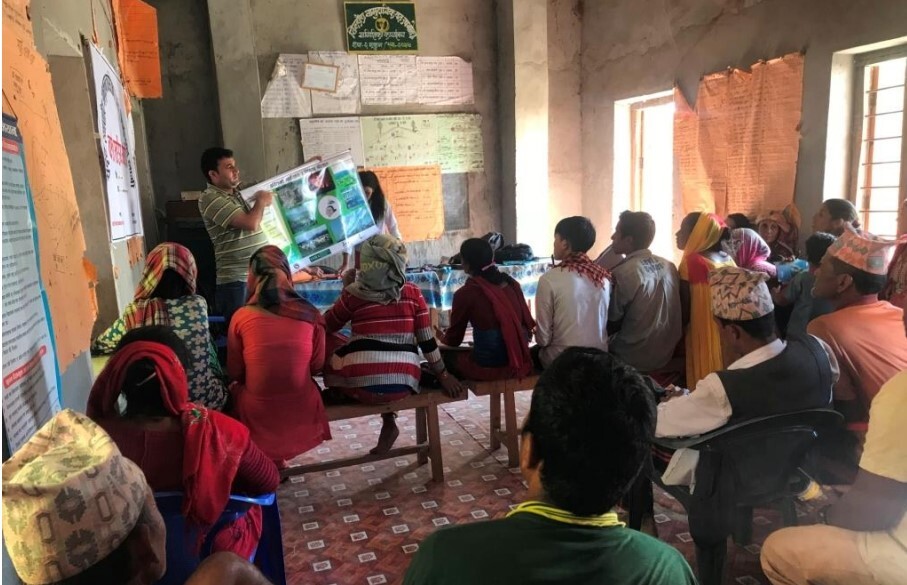
photo via pxhere
Issue
Deforestation and forest degradation continue to be major barriers to climate mitigation, adaptation and biodiversity conservation
Solution
Community forestry, a management approach pioneered in Nepal, is one of the most successful approaches for implementing forest-related nature-based solutions
Forest ecosystems and biodiversity are threatened by climate change
Forests are one of the major land-use systems in Nepal, covering 45% of the total land of the country and supporting the livelihoods of over 65% of the population. Forest goods and services are critical to rural livelihoods, including Indigenous Peoples (IPs) and local communities, and provide the basic inputs (nutrients, minerals and water) to agriculture and livestock production systems. They have also become the backbone for local and community development activities. Despite significant improvements in forest governance and conservation, Nepal’s forests, biodiversity and watershed management sectors are still facing widespread challenges arising from natural and anthropogenic factors. Deforestation, illegal and unsustainable harvesting practices, encroachment for resettlement and farming, and unplanned infrastructure development are some causes leading to the loss and degradation of forests and associated floral and faunal diversity, increased soil erosion, sedimentation and desertification. Climate change along with associated hazards like droughts, heatwaves and forest fires, drying of water resources and wetlands, extreme rainfall events, floods and landslides are emerging as serious threats to forest ecosystems and biodiversity and watershed degradation. Meanwhile, there is a challenge to enhance the resilience of dependent communities not only through the conservation efforts but also opportunities for productivity improvements and income generation.
Mobilising community forestry for synergistic outcomes
Nepal is a pioneer of community forestry, which is a participatory approach to managing forests under the autonomy vested to forest users. Started in late 1970, over 22,000 community forest user groups manage over one-third of the country's forest resources as entitled under Forest Act 1993 and Forest Regulation 1995. Under the community forestry regime, communities receive direct incentives in terms of ownership to the resources, secured supply of essential forest products (fuel wood, fodder for livestock, ecosystem services, and various non-timer forest products) for their efforts in conserving the forest. Mainly due to the successful adoption of community forestry, Nepal has seen a gradual restoration of forests and significant control of deforestation. Meanwhile, bottom-up planning has greatly helped to design programmes and activities based on the needs and aspirations of local people. Conservation and sustainable management of forests are the obvious nature-based solutions that could help GHG mitigation through carbon storage, conservation of biodiversity and ecosystem services, climate adaptation (EbA), disaster risk reduction (Eco-DRR), eco-tourism, and maintenance of tradition and culture. Key policies and strategies, such as National Forest Policy 2019, Forest Sector Strategy 2016-2025, Second Nationally Determined Contribution 2020, National REDD+ Strategy 2018, have envisioned optimising mitigation, adaptation, biodiversity and livelihood benefits mainly through community focused approaches. Activities include those to promote landscape approaches, conserve, restore and manage habitats and ecosystems, adopt people centric approaches, integrate watershed management, support adaptive capacity of local communities and ecosystems by promoting ecosystem-based and community-based resilience enhancement measures, promote forest-based enterprises, eco-tourism and job creation for livelihood improvements, thereby increasing access to rewards for implementing REDD+ etc. Further, community forestry in Nepal has created strong synergy with 80 targets of SDGs (Aryal et al, 2019).

Ways to promote nature-based solutions through community forestry
Community forest user groups are well positioned to play an important role in promoting forest-related nature-based solutions (NbS) as they are entitled to undertake a range of activities for the betterment of the community. In fact, community forest user groups are already engaged in multiple interventions related to disaster risk reduction (flood and landslides), improvement in water supply through watershed conservation, REDD+ activities for climate mitigation, eco-tourism, and mobilising income from forestry for local development activities (health, education, road construction etc). With its long history, diverse experiences, participatory decision-making, and strong institutional base of community the forestry governance system can be a key enabler to promote forest-related NbS, which in fact are already being practiced but are not fully appreciated. Further diversifying the roles and mandates of community forestry beyond its core focus of forest management could make a major difference in that direction. It is vital to duly recognise and further highlight the potential and effectiveness of nature-based solutions to address prominent expectations in terms of productivity of forest management operations, increased climate resilience, and opportunities for income generation.
Ways to address key barriers
Prioritising NbS into community forestry is an approach that faces some barriers. First, members of community forestry user groups need regular updates about their roles and responsibility to promote various forms of NbS as envisioned in the key policy documents and decisions at national and international levels. Besides awareness-raising activities, capacity building is necessary to understand the concepts, methods and process of applying NbS in an effective manner. As a part of capacity building, strengthening monitoring and evaluation is critical to assess whether the outcomes of NbS are indeed effective to fulfill key expectations of community forestry user groups. Most importantly, technical, financial and institutional support is crucial to overcome the barriers.
Location
Related Information
- K. Aryal, H. K. Laudari & H. R. Ojha (2019): To what extent is Nepal’s community forestry contributing to the sustainable development goals? An institutional interaction perspective, International Journal of Sustainable Development & World Ecology.
- MoFE. (2021). Vulnerability and Risk Assessment and Identifying Adaptation Options in the Forest, Biodiversity and Watershed Management in Nepal. Ministry of Forests and Environment, Government of Nepal. Kathmandu, Nepal.
- Shivakoti, BR., Lopez-Casero, F., Maraseni, T., & Pokharel, K. (2021). Capacity building at community forestry level for synergistic implementation of NDCs’ adaptation and mitigation commitments. APN Science Bulletin, 11(1), 113 – 124.
KEYWORDS
- # Case Study
- # Agriculture
- # Biodiversity/Ecosystem
- # Forests/Forestry
- # Local Communities
- # Water Environment/Water Resources
- # Adaptation Action/implementation
- # Adaptation Planning/Policy
- # Capacity Building
- # Climate Mitigation Co-Benefits
- # Disaster Prevention/Disaster Mitigation
- # Education/Awareness/Information
- # Locally-led Adaptation
- # Nature-based Solutions
- # Participatory Approach
- # Asia
- # Nepal
- # 2021




